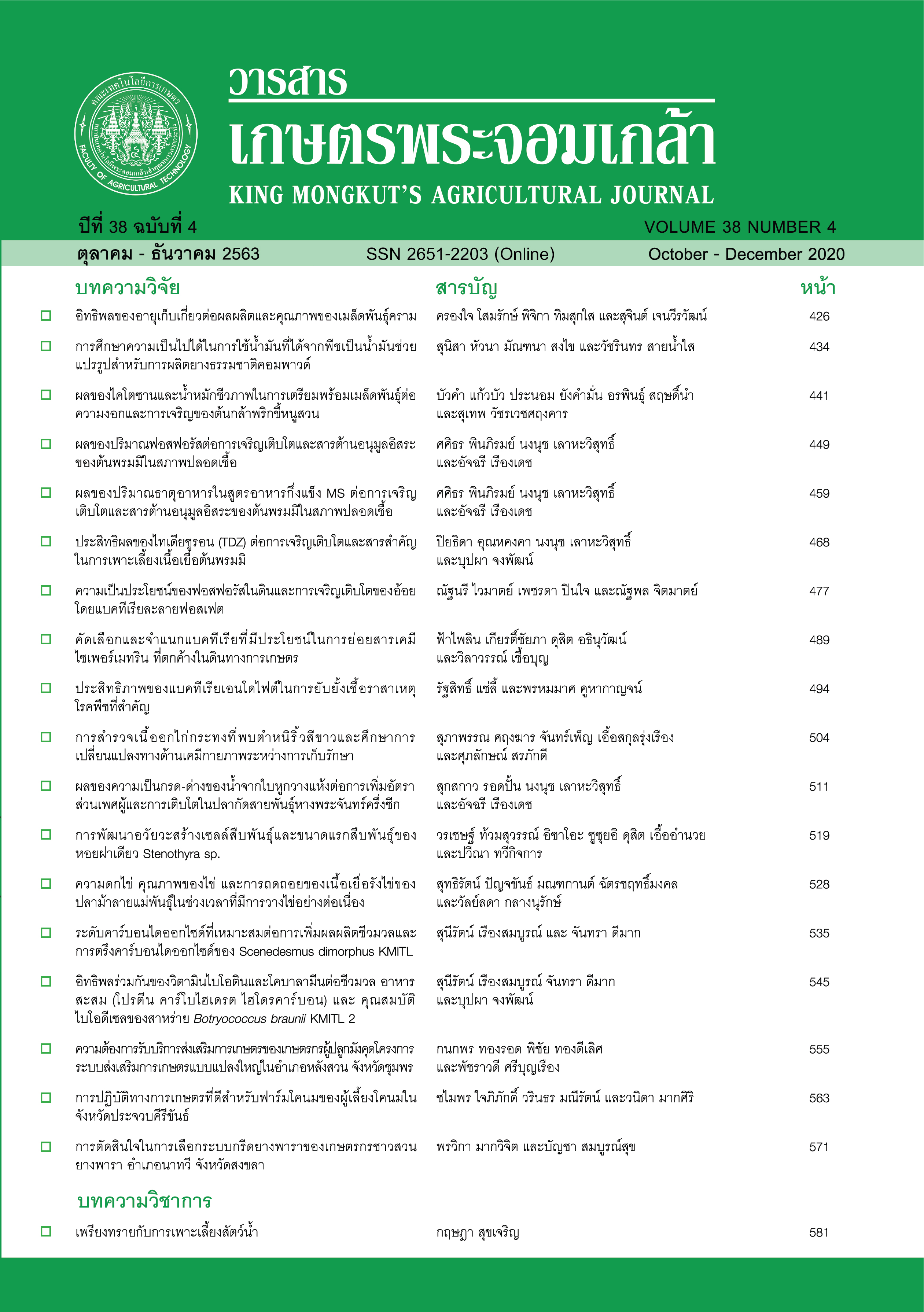ความเป็นประโยชน์ของฟอสฟอรัสในดินและการเจริญเติบโตของอ้อยโดยแบคทีเรียละลายฟอสเฟต
Main Article Content
บทคัดย่อ
งานวิจัยนี้มีวัตถุประสงค์เพื่อศึกษาผลของการใส่แบคทีเรียละลายฟอสเฟต K. radicincitans และ B. subtilis ร่วมกับการใส่ปุ๋ยเคมีและหินฟอสเฟตต่อความเป็นประโยชน์ของฟอสฟอรัสในดิน การเจริญเติบโตและผลผลิตของอ้อยในสภาพไร่ ทำการศึกษาในชุดดินทับพริก จ. สระแก้ว ผลการศึกษาพบว่า การใส่แบคทีเรียละลายฟอสเฟตร่วมกับหินฟอสเฟตมีผลต่อการเพิ่มปริมาณฟอสฟอรัสที่เป็นประโยชน์ในดิน โดยการใส่เชื้อร่วมกัน (2 ไอโซเลต) ร่วมกับการใส่หินฟอสเฟตส่งผลต่อปริมาณฟอสฟอรัสที่เป็นประโยชน์ในดินสูงที่สุด การใส่เชื้อ K. radicincitans ส่งผลต่อการสะสมฟอสฟอรัสในอ้อยสูงที่สุด สอดคล้องกับการดูดใช้ฟอสฟอรัสของอ้อยพบว่าการใส่เชื้อ K. radicincitans ช่วยส่งเสริมการดูดใช้ฟอสฟอรัสในอ้อยได้สูงและแตกต่างอย่างมีนัยสำคัญทางสถิติจากตำรับควบคุมและตำรับการใส่ปุ๋ยยูเรีย (46-0-0) และปุ๋ยโพแทสเซียมคลอไรด์ (0-0-60) การใส่แบคทีเรียละลายฟอสเฟตส่งผลต่อน้ำหนักสดลำ แต่ไม่ส่งผลต่อความสูง เส้นผ่านศูนย์กลางลำ และจำนวนปล้อง การใส่เชื้อแบบเดี่ยว B. subtilis ร่วมกับหินฟอสเฟต และการใส่เชื้อแบบร่วม 2 ไอโซเลต ทำให้อ้อยมีน้ำหนักสดลำสูงใกล้เคียงกันและแตกต่างอย่างมีนัยสำคัญทางสถิติเท่ากับ 880 และ 853 กรัมต่อลำ ตามลำดับ ส่งผลให้อ้อยมีผลผลิตเท่ากับ 12.48 และ 12.15 ตันต่อไร่ สำหรับผลต่อค่าความหวานของอ้อย พบว่าการใส่เชื้อแบคทีเรียละลายฟอสเฟตส่งผลดีต่อค่าความหวานของอ้อย
โดยในตำรับการใส่ร่วมกันทั้ง 2 ไอโซเลต ร่วมกับหินฟอสเฟตมี %CCS สูงที่สุดคือ 14.55 %
Article Details
วารสารเกษตรพระจอมเกล้า
เอกสารอ้างอิง
ฉัตราภรณ์ ทองปนแก้ว. 2559. การคัดเลือกและศักยภาพของแบคทีเรียละลายฟอสเฟตต่อการเจริญเติบโตของอ้อย. วิทยานิพนธ์ปริญญาโท, มหาวิทยาลัยเกษตรศาสตร์. กรุงเทพฯ.
ไตรธานี เยี่ยมอ่อน, นันทวัน ฤทธิ์เดช, ประสิทธิ์ ใจศิล และโสภณ บุญลือ. 2555. การส่งเสริมการเจริญเติบโตของอ้อยด้วยแบคทีเรียละลายฟอสเฟตในสภาพเรือนทดลอง. แก่นเกษตร 3 (พิเศษ): 185-193.
เพชรดา ปินใจ, เสาวนุช ถาวรพฤกษ์, ณัฐพล จิตมาตย์, ทิมทอง ดรุณสนธยา, สุรเชษฎ์ อร่ามรักษ์, รัฐนนท์ เจริญชาศรี, มิตรา วัฒนา,
กรรณิการ์ หอมยามเย็น, ดวงใจ วัยเจริญ และเบญจลักษณ์ วังไธสง. 2560. ศักยภาพของการใช้แบคทีเรียละลายฟอสเฟตต่อการละลายฟอสเฟตในดินและการเพิ่มการเจริญเติบโตและผลผลิตของอ้อยในจังหวัดสระแก้ว. ใน รายงานวิจัยฉบับสมบูรณ์ (โครงการย่อยที่ 2) การเพิ่มประสิทธิภาพการจัดการธาตุอาหารพืชตามดัชนีผลิตภาพดินเพื่อเพิ่มผลผลิตอ้อยในจังหวัดสระแก้ว. สำนักงานกองทุนสนับสนุนการวิจัย.
สมศรี บุญเรือง, รังสิมันต์ สัมฤทธิ์ และคมณัฏฐ์ ธีระนุกูล. 2552. การปลูกอ้อย: เอกสาร คำแนะนำ ที่ 159. กรมส่งเสริมการเกษตร สำนักส่งเสริมและจัดการสินค้าเกษตร, กรุงเทพฯ.
เสาวนุช ถาวรพฤกษ์, ณัฐพล จิตมาตย์, ทิมทอง ดรุณสนธยา, สุมิตรา วัฒนา, ดวงใจ วัยเจริญ, กรรณิการ์ หอมยามเย็น, รัฐนนท์ เจริญชาศรี และราชัน เลิศพยัคฆ์รัตน์. 2557. การจัดชั้นสมรรถนะความอุดมสมบูรณ์และศักย์ผลิตภาพของดินที่ใช้ปลูกอ้อยในภาคตะวันออกของประเทศไทย. ใน รายงานวิจัยฉบับสมบูรณ์ (โครงการย่อยที่ 1) ภายใต้แผนงานวิจัยการพัฒนาดัชนีคุณภาพและผลิตภาพของดิน
เพื่อการผลิตอ้อยในภาคตะวันออกของประเทศไทย. สำนักงานกองทุนสนับสนุนการวิจัย.
Adeleke, R., Nwangburuka, C., and Oboirien, B. 2017. Origins, roles and fate of organic acids in soils: A review. South African Journal of Botany 108: 393-406.
Akhtar, N. I., Arshad, M. A., Shakir, M. A., Qureshi, J., and Sehrish, A. L. 2013. Co-inoculation with Rhizobium and Bacillus sp. to improve the phosphorus availability and yield of wheat (Triticum aestivum L.). Journal of Animal and Plant Sciences
: 190-197.
Bachchhav, S. 2005. Fertigation technology for increasing sugarcane production. Indian Journal of Fertilisers 1: 85-89.
Bache, B. W. 1964. Aluminum and iron phosphate studies related to soils. II Reaction between phosphates and hydrous oxides. European Journal of Soil Science 15: 110-116.
Bray, R. H., and Kurtz, L. T. 1945. Determination of total, organic and available forms of phosphorus in soils. Soil Science 59: 39-45.
Henri, F., Laurette, N. N., Annette, D., John, Q., Wolfgang, M., François-Xavier, E., and Dieudonne, N. 2008. Solubilization of inorganic phosphates and plant growth promotion by strains of Pseudomonas fluorescens isolated from acidic soils of Cameroon. African Journal of Microbiology Research 2: 171-178.
Illmer, P. A., and Schiner, F. 1992. Solubilization of inorganic phosphate by microorganism isolate from forest soil. Soil Biology Biochemistry Journal 24: 389-395.
Indi, D., Nalawade, S. V., Deshmukh, S. U., and Pawar, S. M. 2014. Response of sugarcane varieties to nitrogen and phosphorus as inoculated by gluconacetobacter diazotrophicus and PSB. Indian Journal of Pharmaceutical Sciences 3: 260-269.
Kaur, G., and Reddy, M. S. 2015. Effects of phosphate-solubilizing bacteria, rock phosphate and chemical fertilizers on maize-wheat cropping cycle and economics. Pedosphere 25: 428-437.
Kloepper, J. W., Lifshitz, K., and Schroth, M. N. 1988. Pseudomonas inoculants to benefit plant production. ISI Atlas of Science Animal and Plant Sciences 1: 60-64.
Khan, A. A., Jilani, G., Akhtar, S. M., Navi, S. M. S., and Rasheed, M. 2009. Phosphorus solubilizing bacteria: occurrence, mechanisms and their role in crop production. Journal of Agricultural and Biological Science 1: 48-58.
Lopez, E. F., and Gomez, E. F. 1996. Simultaneous determination of the major organic acids, sugars, glycerol, and ethanol by HPLC in grape musts and white wines. The Journal of Chromatographic Science 34: 254-257.
Murphy, J., and Riley, J. P. 1962. A modified single solution method for the determination of phosphate in natural waters.
Analytica Chimica Acta 27: 31-36.
Parfitt, R. L. 1989. Phosphate reactions with natural allophane, ferrihydrite and goethite. The European Journal of Soil Science
: 359-369.
Ryan, P. R., Delhaize, E., and Jones, D. L. 2001. Function and mechanism of organic anion exudation from plant roots.
Annual Review of Plant Physiology and Plant Molecular Biology 52: 527-560.
Poonguzhali, S., Madhaiyan, M., and Sa, T. 2008. Isolation and identification of phosphate solubilizing Bacteria from Chinese cabbage and their effect on growth and phosphorus utilization of plants. Journal of Microbiology and Biotechnology
: 773-777.
Sadia, A., Samina, K., Najma, A., and Maliha, R. 2002. In vitro solubilization of inorganic phosphate by phosphate solubilizing microorganisms (PSM) from maize rhizosphere. International Journal of Agriculture and Biology 4: 454-458.
Sadiq, H. M., Jahangir, G. Z., Nasir, I. A., Iqtidar, M., and Iqbal, M. 2013. Isolation and characterization of phosphate-solubilizing bacteria from rhizosphere soil. Biotechnology & Biotechnological Equipment 27: 4248-4255.
Saeid, A., Prochownik, E., and Dobrowolska-Iwanek, J. 2018. Phosphorus solubilization by bacillus species. Molecules 23: 2897.
Safirzadeh, S., Chorom, M., and Enayatizamir, N. 2019. Effect of phosphate solubilising bacteria (Enterobacter cloacae) on phosphorus uptake efficiency in sugarcane (Saccharum officinarum L.). Soil Research 57(4): 333-341.
Sharma, S. B., Sayyed, R. Z., Trivedi M. H., and Gobi, T. A. 2013. Phosphate solubilizing microbes: sustainable approach for managing phosphorus deficiency in agricultural soils. Springer Plus 2: 587-600.
Sperberg, J. I. 1958. The incidence of apatite-solubilizing organisms in the rhizosphere and soil. Australian Journal of Agricultural Research 9: 778-781.
Sundara, B., Natarajan, V., and Hari, K. 2002. Influence of phosphorus solubilizing bacteria on the changes in soil available phosphorus and sugarcane and sugar yield. Field Crop Research 77: 43-49.
Syers, J. K., Johnston, A. E., and Curtin, D. 2008. Efficiency of soil and fertilizer phosphorus use: Reconciling changing concepts of soil phosphorus behaviour with agronomic information. Rome: Food and Agricultural Organization of the United Nations.
Vikram, A., and Hamzeharghani, H. 2008. Effect of Phosphate solublizing bacteriaon nodulation and growth parameters of greengram (Vigna Radiata L. wilezek.). Research Journal of Microbiology 3: 62-72.
Walpola, B. C., and Yoon, M. H. 2013. Phosphate solubilizing bacteria: Assessment of their effect on growth promotion and phosphorous uptake of mung bean (Vigna radiata (L.) R. Wilczek). Chilean Journal of Agricultural Research 73: 275-281.
Yadav, S. P., Kuma, A., Yadav, S., Singh, A. K., Tiwari, A. K., and Ram, B. 2016. Yield, quality and nutrient uptake in autumn sugarcane as influenced by phosphorus levels and inoculation of phosphate solubilizing bacteria in legume based intercropping systems. Indian Journals 5: 63-65.
Yu, X., Liu, X., Zhu, T., Liu, G., and Mao, C. 2011. Isolation and characterization of phosphate-solubilizing bacteria from walnut and their effect on growth and phosphorus mobilization. Biology and Fertility of Soils 47: 437-446.


